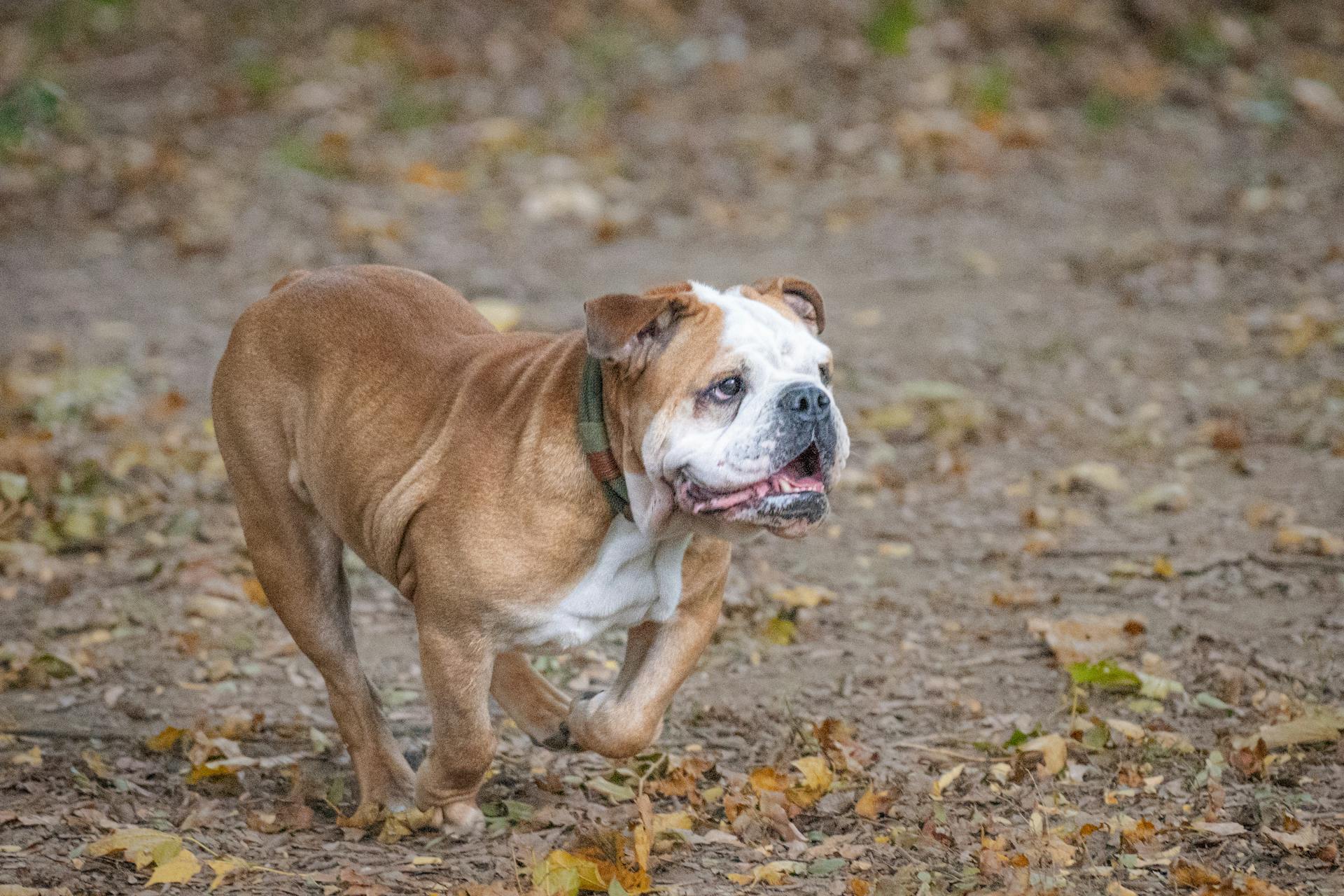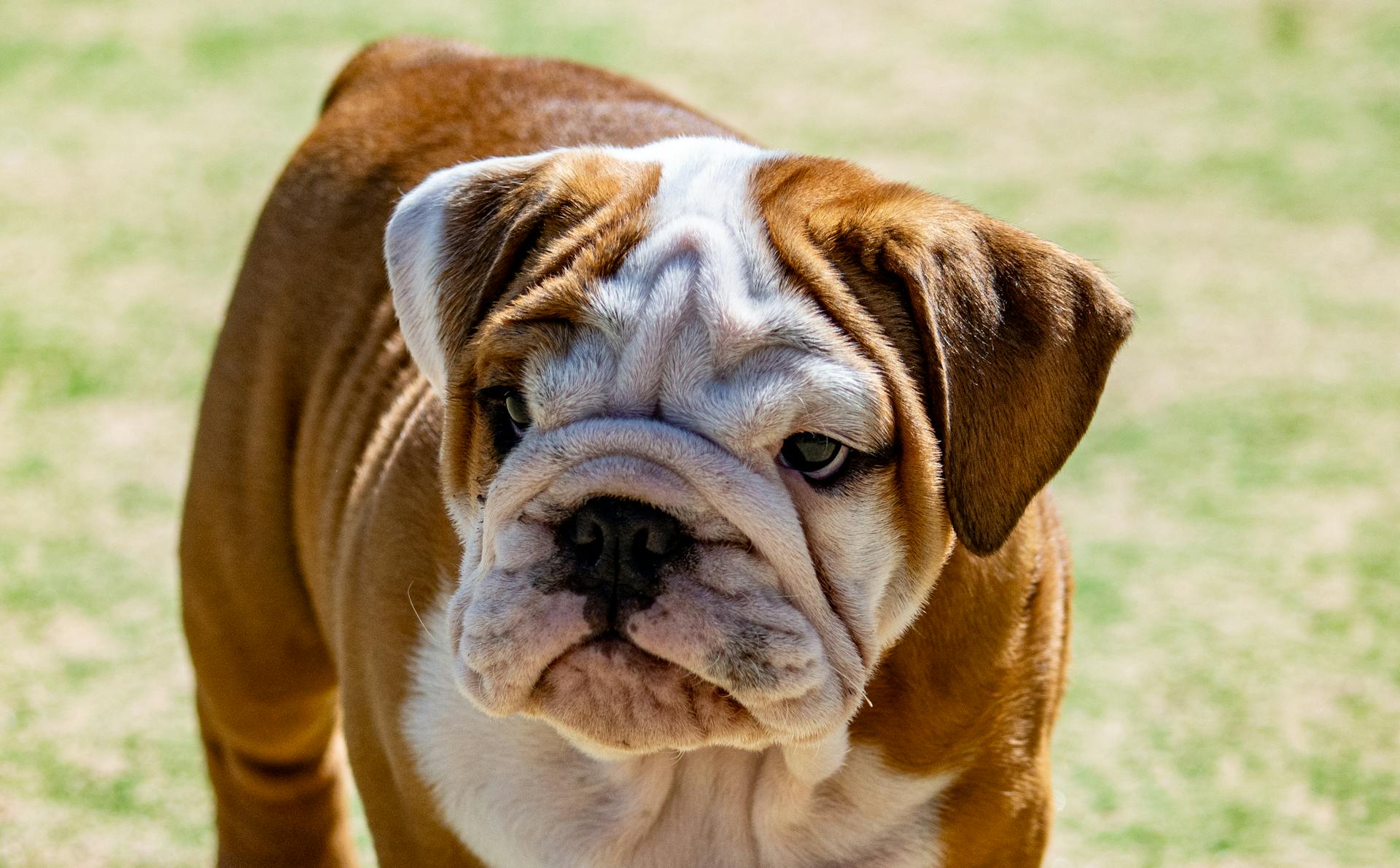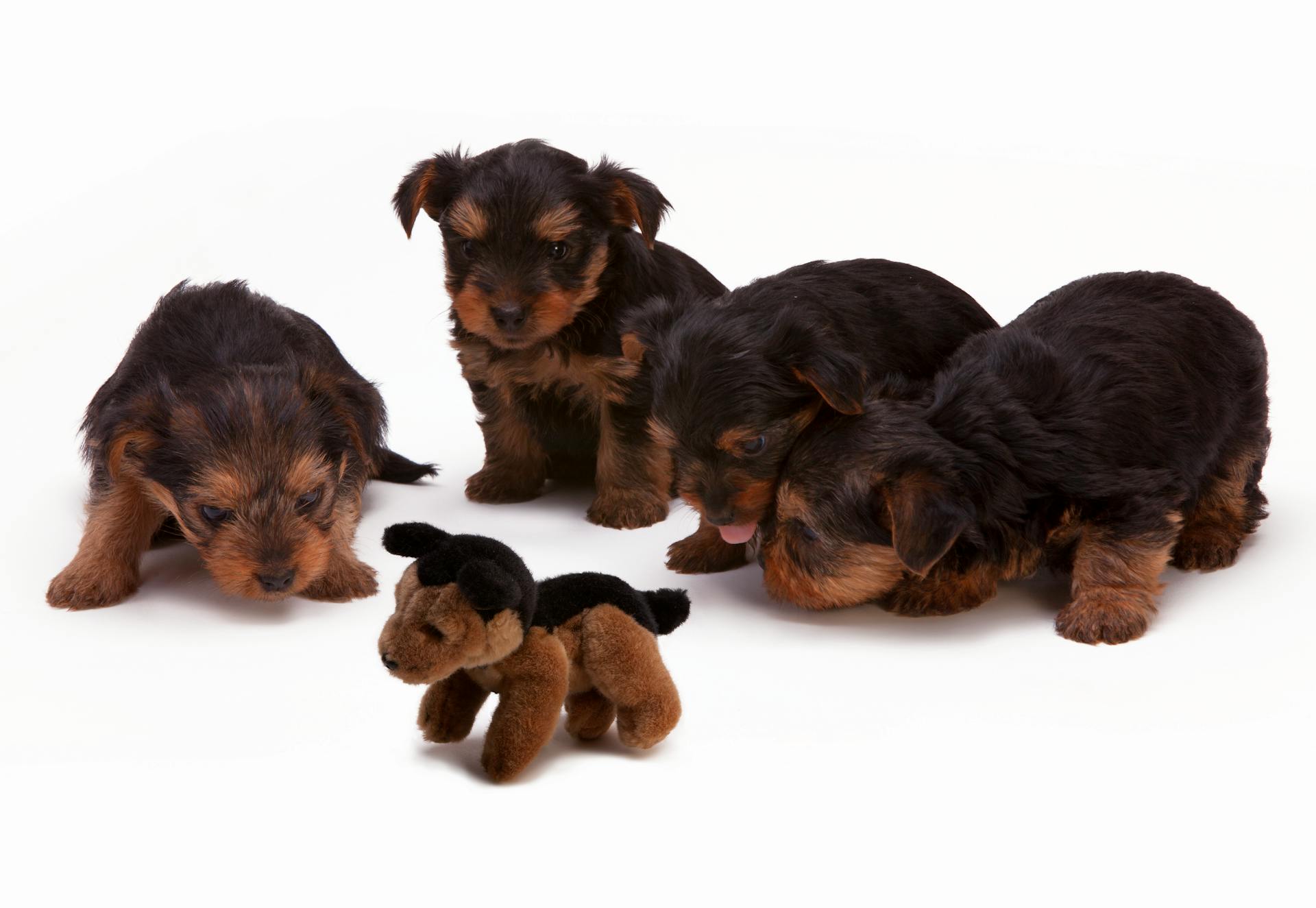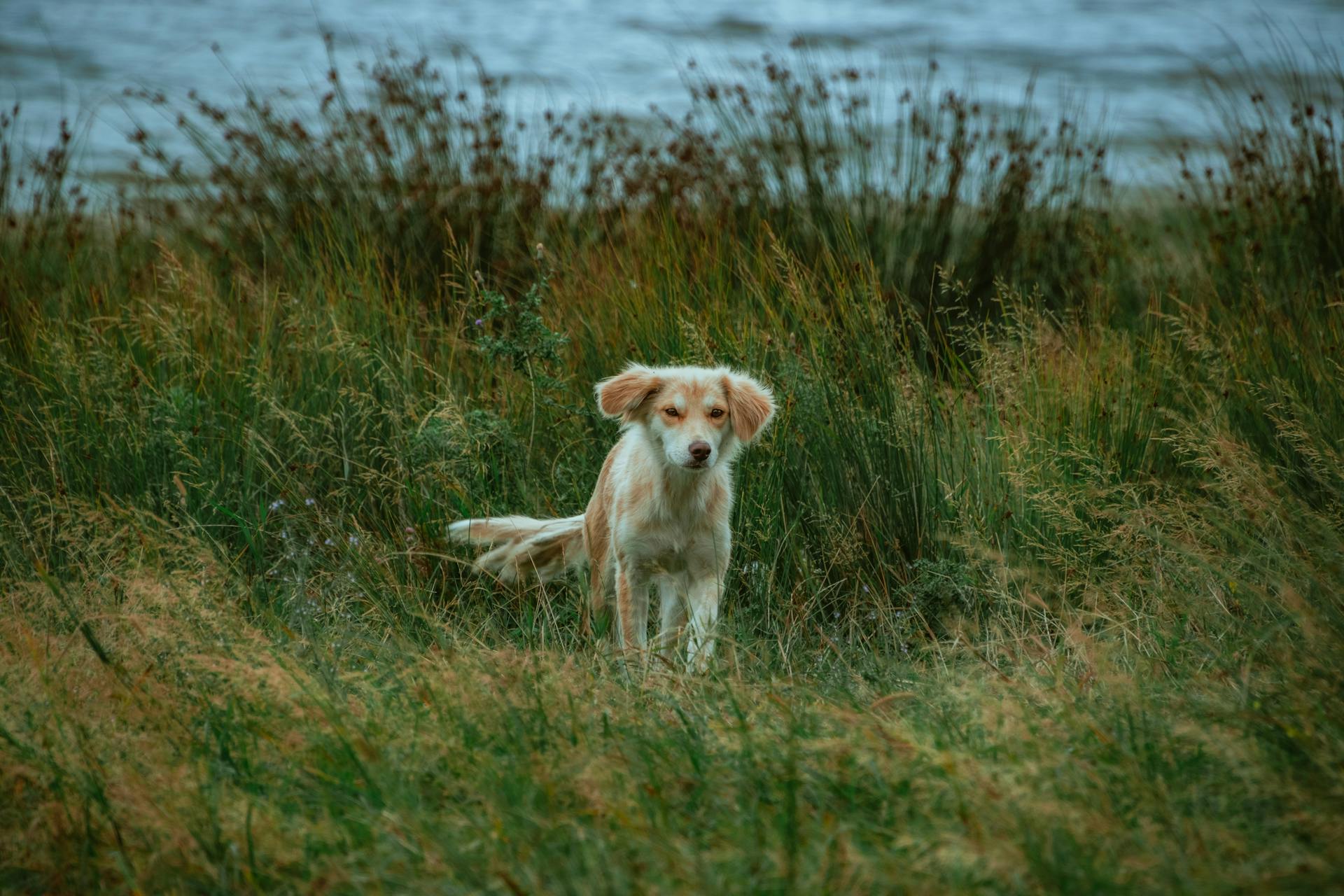If you're considering bringing an Olde English Bulldogge into your family, it's essential to find a reputable breeder. Olde English Bulldogge breeders prioritize the health and well-being of their dogs, so look for breeders who health test their breeding stock and provide a guarantee.
Olde English Bulldogges are a relatively new breed, developed in the 1970s by David Leavitt. They were created by crossing bulldogs with other breeds to restore the original characteristics of the ancient English bulldog.
These dogs are known for their friendly, outgoing personalities and are often described as " Velcro dogs" due to their strong attachment to their family members.
If this caught your attention, see: Are Pit Bulls Good Family Dogs
Your Bulldogge's Health
Your Olde English Bulldogge's health is a top priority, and it's great that you're taking the time to learn more about their unique needs. Caring for your Bulldogge requires attention to their genetic predispositions, which can increase their risk of certain health issues.
Brushing your dog's teeth daily is crucial to prevent periodontal disease, which can be a significant problem for Olde English Bulldogges. This simple habit can make a big difference in their overall health.
In addition to dental care, regular grooming sessions are essential to keep your Bulldogge clean and healthy. Brush their coat at least weekly, and clean their ears and wrinkles regularly, as some Bulldogs may require more frequent cleanings.
Proper nutrition and exercise are also vital for your Bulldogge's health. Feed a high-quality diet appropriate for their age, and avoid giving them people food. Exercise regularly, but don't overdo it at first, as they can be sensitive to warm temperatures and may be prone to heat stress.
Common health issues that may affect your Olde English Bulldogge include hypothyroidism, heart disease, and obesity. Regular veterinary care, proper nutrition, and regular grooming sessions can help prevent these common ailments.
Here are some key health tips to keep in mind:
- Brush your Bulldogge's teeth daily to prevent periodontal disease.
- Clean their ears and wrinkles regularly, as needed.
- Feed a high-quality diet appropriate for their age.
- Avoid giving them people food.
- Exercise regularly, but don't overdo it at first.
- Be mindful of their sensitivity to warm temperatures and watch for signs of heat stress.
Care and Management
As an Olde English Bulldogge owner, you'll want to prioritize their care and management to ensure they live a happy and healthy life.
They have relatively low grooming needs, requiring only a weekly coat brushing.
Olde English Bulldogges are intelligent and energetic, so it's essential to keep their minds and bodies active to prevent boredom and naughty behavior.
A consistent diet is crucial, and you should avoid giving them people food. Instead, feed a high-quality diet suitable for their age.
Exercise is also vital, but it's essential to start slowly and not overdo it, especially at first. A daily walk, run, or game of fetch will suffice.
Here's a quick rundown of their care needs:
- Supervise your pet as you would a toddler, keeping doors closed and picking up after yourself to avoid trouble.
- Brush their coat weekly, clean their ears weekly, and brush their teeth at least twice a week.
- Keep their diet consistent and avoid overexertion, especially in warm temperatures.
- Exercise them regularly, but don't overdo it at first.
By following these simple care and management tips, you'll be well on your way to raising a happy and healthy Olde English Bulldogge.
Bulldogge Puppies and Temperament
Olde English Bulldogge puppies are known for their affectionate and submissive nature, making them a great fit for families.
They love to play and are high-spirited, never shying away from snuggles or work. An overly shy Olde English Bulldogge is considered a breeding fault, likely due to poor socialization in puppyhood.
To ensure your puppy grows into a confident and friendly adult, it's essential to provide them with proper socialization from an early age.
Here are some key temperament traits to expect from an Olde English Bulldogge:
By understanding these temperament traits, you can better prepare yourself for the joys and challenges of owning an Olde English Bulldogge puppy.
Bulldogge Puppies
If you're looking to bring an Olde English Bulldogge puppy into your family, you'll need to find a reputable breeder who can guarantee a 100% genetically pure puppy.
You can find a list of breeders through the Leavitt Bulldog Association, which puts their puppies through extensive medical screening to ensure they're healthy and well-bred.
Breeders through the Leavitt Bulldog Association put their puppies through extensive medical screening to ensure the breed is a top-notch, beautifully healthy breed.
As a rule of thumb, if your Olde English Bulldogge does not come with registration papers, it’s not worth the buy.
Take a look at this: Healthiest Bulldog Breed
Olde English Bulldogges weigh between 50 to 80 pounds and come in a variety of colors including brindle, white, fawn, red, and black.
They're a robust breed that's suitable for active families or singles who can provide them with plenty of exercise and attention.
Olde English Bulldogges are known for being confident, friendly, alert, expressive, and docile, making them a great addition to any family.
They're short-lived dogs, unfortunately, and are prone to health problems, but with proper care and attention, they can live happy and healthy lives.
If you're considering bringing an Olde English Bulldogge puppy into your family, you can expect to pay for a reputable breeder who can guarantee a 100% genetically pure puppy.
You'll also need to consider the cost of veterinary care and potential health problems that may arise.
Olde English Bulldogges are a wonderful breed that thrives on attention and interaction, so be prepared to spend plenty of time with your new furry friend.
Worth a look: English Bulldog Skin Rash on Belly
Three Little-Known Facts About the Bulldogge
The Bulldogge is a breed that's often misunderstood, but it's also full of surprises. One little-known fact is that the Bulldogge was originally bred for bull baiting, a cruel blood sport that was popular in England in the 18th and 19th centuries.
The Bulldogge's unique appearance is a result of its history as a fighting breed. Its distinctive wrinkles and underbite are characteristics that were bred into the breed to make it more aggressive and intimidating.
Despite its tough reputation, the Bulldogge is actually a gentle and affectionate breed. According to breeders, the Bulldogge is known for its calm and even-tempered nature, making it a great companion for families with children.
Bulldogges are also surprisingly athletic, despite their sturdy build. They require regular exercise to stay healthy and happy, and they excel in dog sports such as agility and obedience training.
A unique perspective: Game Bred American Pit Bull Terrier
Health Conditions
Olde English Bulldogges are generally a healthy breed, assuming you purchase your puppy from a reputable breeder. They are less prone to breathing, dental, hip, and joint issues compared to other bulldog breeds.
However, all dogs can still develop certain health conditions, regardless of breed. These include allergies, dental disease, obesity, tick and flea-borne illnesses, and more. Regular veterinary care, proper nutrition, and regular grooming sessions can help prevent these common ailments.
Some specific health concerns to be aware of in Olde English Bulldogges include hip dysplasia, hypothyroidism, and heart disease. Brushing your dog's teeth daily can also help prevent periodontal disease.
Infections
Olde English Bulldogges are susceptible to bacterial and viral infections, just like all dogs.
These infections can be prevented through vaccination, which is recommended based on the diseases common in our area, the dog's age, and other factors.
Parvo, rabies, and distemper are some of the infections that can affect Olde English Bulldogges.
Vaccination is a crucial step in protecting your Olde English Bulldogge from these preventable infections.
Hip Dysplasia
Hip dysplasia is a common health issue in Olde English Bulldogges, an inherited disease that causes the hip joints to form improperly and leads to arthritis.
You may notice your dog has lameness in his hind legs or has difficulty getting up from lying down, which is a sign of hip dysplasia.
Brushing your dog's teeth daily can help prevent periodontal disease, a condition that can also be a result of hip dysplasia.
Overweight dogs may develop arthritis years earlier than those of normal weight, causing undue pain and suffering.
We can treat the arthritis with X-rays of your dog's joints to identify the disease as early as possible, and in severe cases, surgery may be considered.
Your veterinarian can help you create a preventive health plan to watch for and hopefully prevent some predictable risks associated with hip dysplasia.
Curious to learn more? Check out: How Old Is Too Old to Clip a Dog's Ears?
Knee Problems
The Olde English Bulldogge, while generally considered a healthier breed, can still be prone to knee problems. This is particularly true for patellar luxation, where the kneecap slips out of place.
You might notice your Bulldogge running and then suddenly picking up a back leg and skipping or hopping for a few strides. This is a common symptom of patellar luxation.

If the problem is mild and involves only one leg, your friend may not require much treatment beyond arthritis medication. This can help manage the symptoms and prevent further discomfort.
In severe cases, surgery may be needed to realign the kneecap and keep it from popping out of place. This is a more serious condition that requires professional attention.
General Information
The Olde English Bulldogge is a robust breed, weighing between 50 to 80 pounds.
These dogs come in a variety of colors, including brindle, white, fawn, red, and black, with solid colors often accompanied by white markings.
Olde English Bulldogges are suitable for active families or singles, who can provide the necessary exercise and attention they need.
Breed History
The Olde English Bulldogge has a rich history that dates back to the early 1970s when David Leavitt, a breeder from the United States, began working on the breed. He aimed to recreate the "Regency Period Bull Baiter" with a less aggressive temperament.
The foundation crosses consisted of one-half Bulldog, one-sixth American Bulldog, one-sixth Bullmastiff, and one-sixth of other breeds. This unique combination of breeds helped to create a dog with the look, health, and athleticism of the original bull-baiting dogs.
In 1971, Leavitt began his project using a linebreeding scheme developed by Dr. Fechimer of Ohio State University. This breeding scheme was designed to rapidly achieve a purebred dog.
The Olde English Bulldogge was initially developed to be a less aggressive and more powerful breed than its parent breeds. It was also bred to have fewer breathing problems and less trouble with birthing.
Here are some key figures involved in the development of the Olde English Bulldogge:
- David Leavitt: Developed the breed in the early 1970s
- Dr. Fechimer: Developed the linebreeding scheme used in the breeding project
- Ben and Karen Campetti: Worked closely with Leavitt in breeding the Olde English Bulldogge
- Michael Walz: Took over the OEBA registry and breeding stock from Leavitt in 1993
The Olde English Bulldogge was recognized by the United Kennel Club (UKC) on January 1, 2014, after being enrolled with the Canine Developmental Health and Performance Registry (CDHPR) in 2008.
Information and Pictures
The general information about a particular topic is readily available, but it's often scattered and hard to find. You can find information on the topic's history in the "Origins" section, which dates back to the early 19th century.

The topic's popularity can be seen in its widespread use across various industries, with over 50% of companies using it in their operations. This is a result of its versatility and efficiency.
The topic's applications are diverse, ranging from healthcare to finance, as mentioned in the "Applications" section. It has also been used in various research studies to improve outcomes.
The topic's impact on society is significant, with estimates suggesting that it has saved millions of dollars in costs and improved the quality of life for millions of people. This is a direct result of its widespread adoption.
You can find more information on the topic's current trends and statistics in the "Statistics" section, which is regularly updated to reflect the latest developments.
Sources
Featured Images: pexels.com


